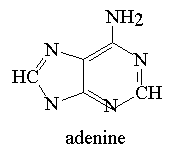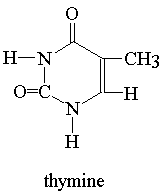

*This website was produced as an assignment for an undergraduate course at Davidson College.*
How does the Oligo(dT) column work?
The use of Oligo(dT) for the purification of mRNA relies on the structure of the molecule relative to that of mRNA. During post-trancriptional processing, a polyA tail is added to the 3' end of mRNA. This polyA tail is composed of 100-300 adenine residues (Heller et al., 2001). Adenine residues, two ring purine bases, are complementary to thymine residues, pyrimidines composed of one ring. The structures of adenine and thymine are shown below. These bases have two hydrogen bonds when they bind double-stranded DNA.


Figure 2. The polyA tail of mRNA is made up of many adenines. Oligo(dT) is composed of many thymines. Since A and T are complementary bases, the Oligo(dT) binds mRNA.
In general, Oligo(dT) purification consists of extracting RNA from tissue and allowing it to hybridize with beads (either latex or magnetic) coated with oligo(dT). Each Oligo(dT) string has approximately 30 thymine residues (Chow et al., 1988). The covalent linkage that binds oligo to beads is very strong and can tolerate harsh conditions associated with lysis and binding protocols; therefore, the oligo(dT) molecules remain covalently attached to the support matrix (Abgene). For example, Abgene® advertizes that their latex Oligo(dT) beads have an average size of 860 nm, hence they are sufficiently small to be almost collidal in nature and provide a large surface area for active components (Abgene).
The figure below illustrates the general procedure for isolation of mRNA from the mixture of ctoplasmic RNA.
.
Figure 3. Messenger RNA is isolated from the cytoplasmic mixture of RNA using the oligo(dT) matrix shown at right in a column. You can wash away tRNA and rRNA not bound to the matrix beads and then elute the mRNA from the column using a low-salt buffer. Currently seeking permission for use of this image found at the site: <http://ww2.mcgill.ca/biology/undergra/c200a/sec2-6.htm>.
So now that you have purified mRNA, what are you to do with it?
See next page to explore the use of the isolated mRNA.
back to Caroline's homepage